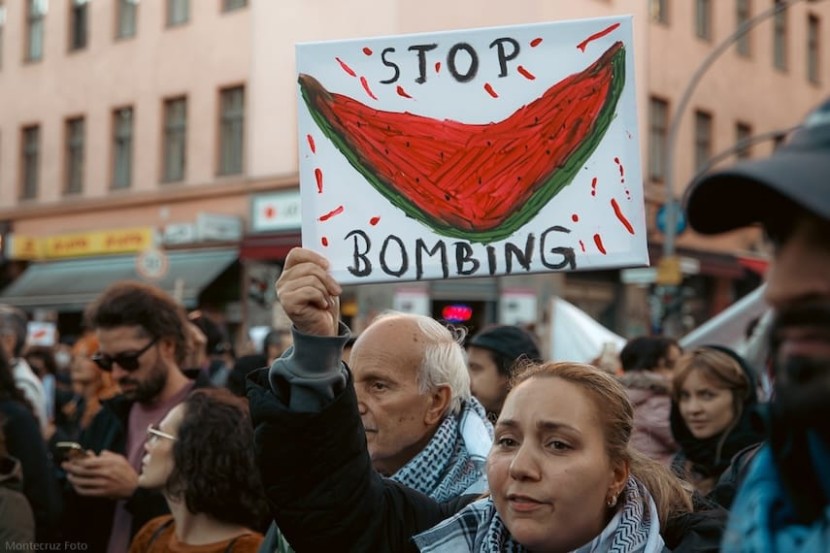One significant piece of imagery has emerged around the world in protests against Israel's war on Gaza: the mighty watermelon, a powerful symbol for Palestinians. The colors of sliced watermelon -- with red pulp, green-white rind, and black seeds are the same as those of the Palestinian flag.

Over the past three months, the fruit has been seen on poster signs, t-shirts, and countless social media posts in protest against Israel's war on Gaza.
However, the use of the watermelon as a Palestinian symbol is not a new phenomenon. It first emerged after the Six-Day War in 1967, when Israel seized control of the West Bank and Gaza, and annexed East Jerusalem. At the time, the Israeli government made public displays of the Palestinian flag a criminal offense in Gaza and the West Bank. To outwit the ban, Palestinians began using the watermelon as a form of resistance and representation. When cut open, the fruit bears the national colors of the Palestinian flag.
According to TIME Magazine, the Israeli government didn't just crack down on the flag. Artist Sliman Mansour told The National in 2021 that Israeli officials in 1980 shut down an exhibition at 79 Gallery in Ramallah featuring his work and others, including Nabil Anani and Issam Badrl. "They told us that painting the Palestinian flag was forbidden, but also the colors were forbidden. So Issam said, 'What if I were to make a flower of red, green, black, and white?', to which the officer replied angrily, 'It will be confiscated. Even if you paint a watermelon, it will be confiscated,'" Mansour told the outlet.
Israel lifted the ban on the Palestinian flag in 1993, as part of the Oslo Accords, which warranted mutual recognition by Israel and the Palestinian Liberation Organization and were the first formal agreements to try to resolve the decades-long Israeli-Palestinian conflict. The flag was accepted as representing the Palestinian Authority, which would administer Gaza and the West Bank.
In a New York Times article published in 1993, Times journalist, John Kifner wrote, "In the Gaza Strip, where young men were once arrested for carrying sliced watermelons-thus displaying the red, black and green Palestinian colors-soldiers stand by, blasé, as processions march by waving the once-banned flag."
In 2007, just after the Second Intifada, artist Khaled Hourani created The Story of the Watermelon for a book entitled Subjective Atlas of Palestine. In 2013, he isolated one print and named it The Colours of the Palestinian Flag, which has since been seen by people across the globe.
The use of the watermelon as a symbol resurged in 2021, following an Israeli court ruling that Palestinian families based in the Sheikh Jarrah neighborhood in East Jerusalem would be evicted from their homes to make way for settlers. Increasingly, young activists have adopted the watermelon as a way to call for a cease-fire in Gaza. The symbol has gained momentous popularity and is widely used around the globe to illustrate solidarity with the Palestinian people.
What Has Reaction To The Watermelon Been?
Per The Associated Press, a year ago, Israel's far-right National Security Minister Itamar Ben-Gvir banned Palestinian flags in public places. This effort was met with fervent opposition. In response, Zazim, an activist group of Arab and Jewish Israelis, plastered taxis in Tel Aviv with large watermelon stickers that read: "This is not a Palestinian flag."
"Our message to the government is clear," the organization said in a written statement. "We'll always find a way to bypass any absurd ban and we won't stop struggling for freedom of expression and democracy - whether this involves the Pride flag or the Palestinian flag."
For some, embracing the colors of the flag is about striving for freedom and equality rather than necessarily statehood.
"I've never cared for flags or nationalism," says Mayssoun Sukarieh, an expert in Middle Eastern studies at King's College London told the AP. "But when it comes to Palestine, it's a flag of a colonized people who never saw independence. And because it has been banned, it becomes more of a symbol of resistance than it is of nationalism."
Watermelons are not the only symbol to catch on with activists. Other signs of global Palestinian solidarity include keys, spoons, olives, doves, poppies, and the keffiyeh scarf. In November, to connect with the peaceful message of Armistice Day, when many Brits traditionally wear red poppy pins, protesters this year passed out white poppy pins, to commemorate victims of all wars. On the holiday, scores of protesters wearing poppy pins marched across London calling for an end to the war in Gaza.
© 2026 HNGN, All rights reserved. Do not reproduce without permission.









